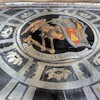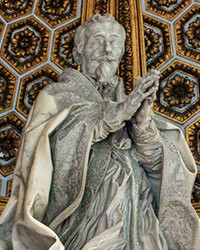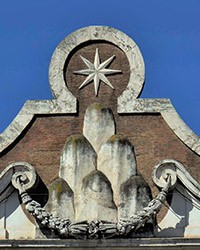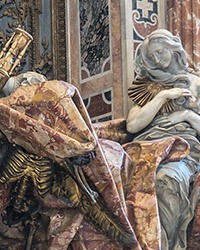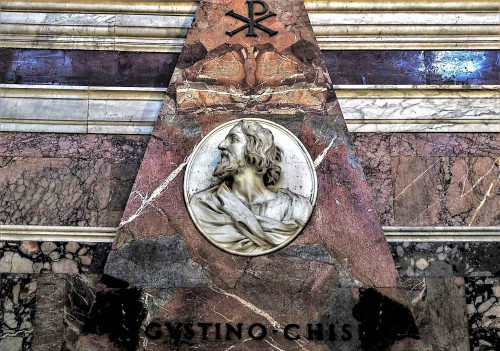
Chigi Chapel, posthumous monument to Agostino Chigi (fragment), Basilica of Santa Maria del Popolo
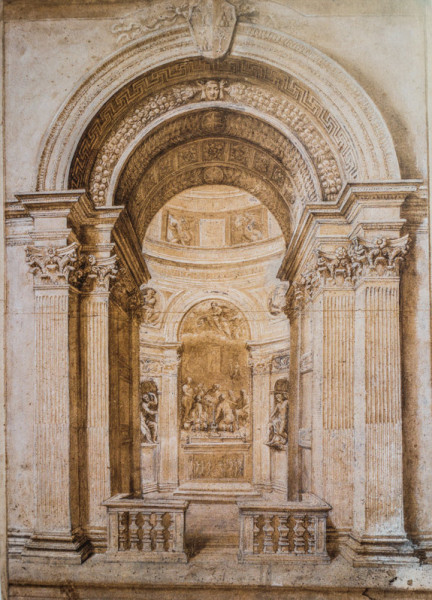
Chigi Chapel, watercolor, Bernini's workshop
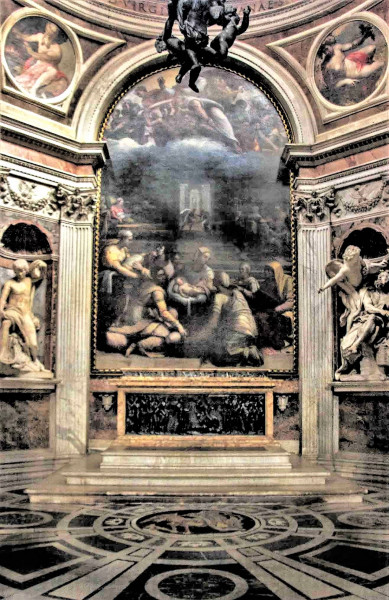
Chigi Chapel, main altar, Basilica Sana Maria del Popolo
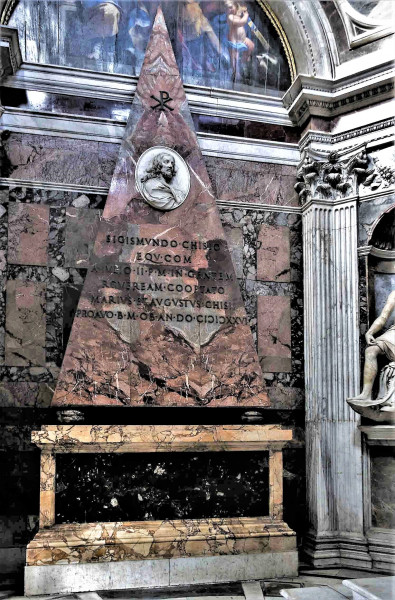
Chigi Chapel, posthumous monument to Sigismundo Chigi, Basilica of Santa Maria del Popolo

Dome of the Chigi Chapel, Basilica of Santa Maria del Popolo
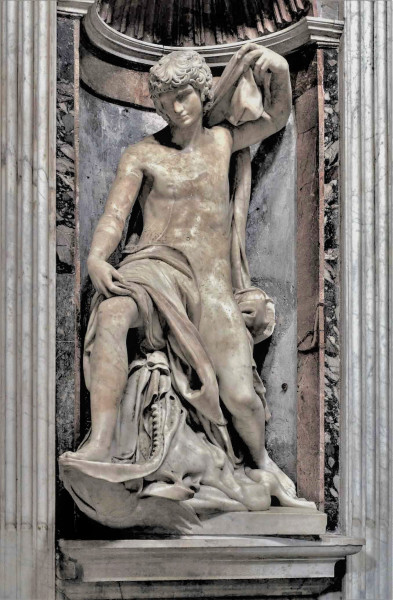
Chigi Chapel, statue of Jonas, Lorenzetto, Basilica Santa Maria del Popolo
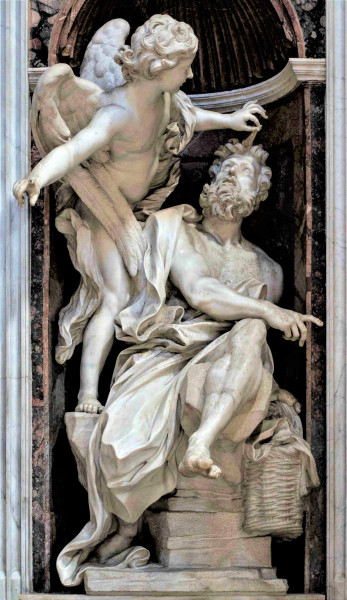
Chigi Chapel, statue of Habakkuk, Gian Lorenzo Bernini, Basilica Santa Maria del Popolo
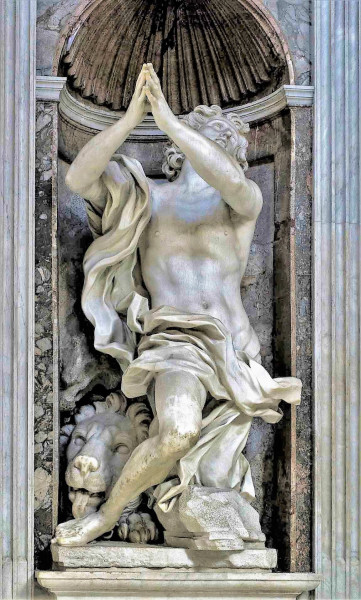
Chigi Chapel, statue of Daniel, Gian Lorenzo Bernini, Basilica Santa Maria del Popolo

Marble floor in the Chigi Chapel, Basilica Santa Maria del Popolo

Chigi Chapel, Basilica of Santa Maria del Popolo
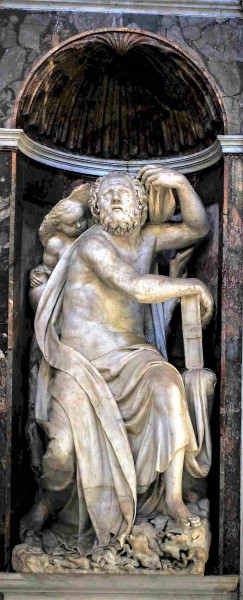
Chigi Chapel, statue of Elijah, Lorenzetto, Basilica Santa Maria del Popolo
It is one of the most magnificent Roman chapels, in which architecture, sculpture, and painting come together into one filled with content whole. Although it was created during the Renaissance, it was enriched in the following eras. Today, finding ourselves inside, we can come to understand the architectural and sculptural concept which had developed during the years and which guided its outstanding creators who let their creativity run wild. Looking upwards, backward, or focusing on details we come to appreciate their work and will leave the chapel filled with esthetic sensations of the highest caliber.
It is one of the most magnificent Roman chapels, in which architecture, sculpture, and painting come together into one filled with content whole. Although it was created during the Renaissance, it was enriched in the following eras. Today, finding ourselves inside, we can come to understand the architectural and sculptural concept which had developed during the years and which guided its outstanding creators who let their creativity run wild. Looking upwards, backward, or focusing on details we come to appreciate their work and will leave the chapel filled with esthetic sensations of the highest caliber.
It all started in 1507, when Pope Julius II, in exchange for financial services provided for him by his trusted banker Agostino Chigi gifted him with a place in the left nave of the renowned Basilica of Santa Maria del Popolo, so that Chigi could create a family chapel here. The banker entrusted its design to the famous at that time in Rome Raphael, who created a central plan of the room topped off with a dome and a design of an arcade relating to antiquity, which adorned its face from the side of the nave. The dome was to be decorated with mosaics, which were also designed by the master from Urbino. They represent the all-powerful God the Creator in the central field and eight heavenly spheres.
At the time of Chigi’s as well as Raphael’s death (1520), works on the chapel were halted. Although Agostino’s widow – Francesca Ordeaschi commissioned the completion of further mosaics to decorate the tholobate, she also died, a few months after her husband. However, a funerary monument was created in the shape of a pyramid (without an inscription or an image), but with a bronze relief adorning it, depicting Christ at a well in the company of a Samaritan woman. As it would later turn out, it was to commemorate not the banker, but his wife. On the other hand, a second pyramid which was to make up Agostino’s monument was not completed. It took 30 years and some heavy criticism, for the Chigi family to finish certain elements of the chapel, in order for the family name to remain unblemished. Paintings, which were begun by Sebastiano del Piombo were finished, entrusted to a Florentine artist who painted in the mannerist style – Francesco Salviati. He also completed the paintings in the tholobate – Genesis as well as the tondi showing the four seasons. At that time the figures of the prophets Jonas and Elijah designed by Raphael and completed by Lorenzetti were placed on either side of the altar.
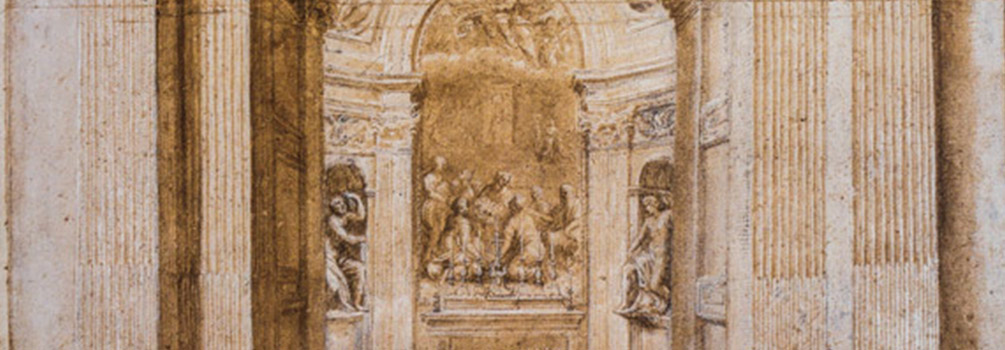
Another important stage in the life of the chapel occurred nearly one hundred years later (1652), due to Cardinal Fabio Chigi (the great-grandnephew of Agostino). He, after coming to Rome from his diplomatic missions and assuming the post of the titular cardinal of the Basilica of Santa Maria del Popolo decided to once again take a closer look at the family chapel and renovate it. With this goal in mind, he employed the most outstanding at this time Roman architect and sculptor, Gian Lorenzo Bernini. He did not do this merely to pay homage to his own family, but also because he himself desired to be buried within. The cardinal did not foresee that soon his plans would change. In 1655 he was elected as pope (Alexander VII) and soon thereafter he made the decision to erect his own funerary monument in the Basilica of San Pietro in Vaticano (the funerary monument of Pope Alexander VII). However, he still, with piety supervised the works on his family chapel, while that which seemed to be difficult to implement due to high costs, after 1655 became plausible and easily accomplished.
What did Bernini do? He erected another pyramid. The first (previously commemorating the wife of the banker) was dedicated to Agostino Chigi, the second to his brother Sigismondo Chigi (the grandfather of Pope Alexander VII). Both were decorated with portrait reliefs made in bronze. In this way, a symmetrical space was created. Its principal element was the altar which had been elevated a few degrees and adorned with the aforementioned slab with the relief (Jesus and the Samaritan Woman). A marble balustrade was also built separating the chapel from the church nave, while the coat of arms of the Chigi family was placed at the finish of the arcade designed by Raphael (from the side of the main nave). The chapel windows were enlarged, the mosaics of the dome restored, similarly to the tholobate and the tondi above the niches, made by Salviati. In addition, paintings showing the royal and priestly roots of the Virgin's family were placed in the lunettes above both the pyramids. However, the most spectacular change took place at the time when the pope decided to add two more statues of prophets to the already existing ones. These were Habakkuk and Daniel who seemed to splendidly fit the ideological program of the interior. However, their placement had to be changed. Habakkuk found himself on the right side of the altar, while Daniel was placed opposite him, on a diagonal. Why? The reason is that the great sculptor and creator of space, such as Bernini, planned not so much two single figures, but a pair of corresponding ones, drawing us into their incredible story, which could only be comprehended if we stood at the center of the line connecting the two sculptures. And thus, the artist connected Daniel in a lion's cave with the figure of Habakkuk found on the diagonal (Bernini’s Habakkuk and an Angel) – the very same who supplied him with, albeit unwillingly at first (as the author suggests) food, understood as a Eucharistic meal.
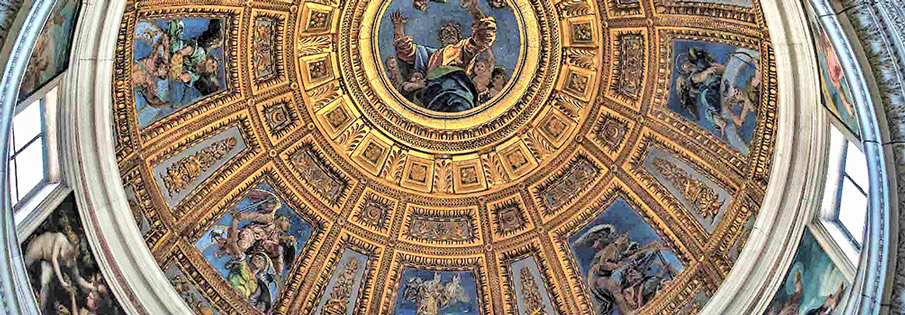
It is often forgotten that the Chigi Chapel was dedicated to the Virgin Mary, and she is the main protagonist here. We can see here in the altarpiece (oil on stone), The Birth of the Virgin, which was started by Sebastiano del Piombo and finished by Francesco Salviati. In this way, the story of the Creation was connected in the dome of the chapel, with a new stage in the history of Christianity, namely the birth of the Savior's mother. The function of the family chapel was, therefore, not purely limited to commemorating the family, but it ensured those laid to rest within constant participation in masses which were celebrated inside, as well as prayers which would ensure them with eternal peace and hope of resurrection. Their bodies were laid to rest in the underground of the chapel, while access to them was granted through a round opening in the floor. It is covered by a marble slab designed by Bernini with an intarsia depicting Death bent over, under the burden of the Chigi coat of arms. Death, depicted as a skeleton, seems to be floating upwards out of the underground, seemingly bypassing the two pyramids, (symbols of immortality), in the direction of God the Almighty, placed in the dome. In this manner, an artist with theatrical inclinations, such as Bernini, marked the posthumous path towards salvation for the Chigi family.
Today the chapel invites us inside, to come in contact with two great artists. Let us not forget to stand in the middle of the diagonal connecting both of Bernini’s prophets, but also allow ourselves to be captured by the heavenly vision of Raphael.




















